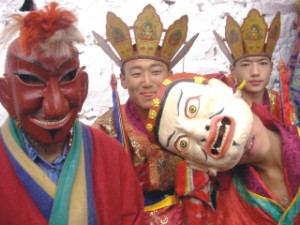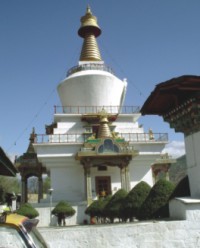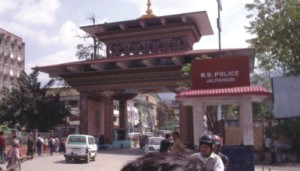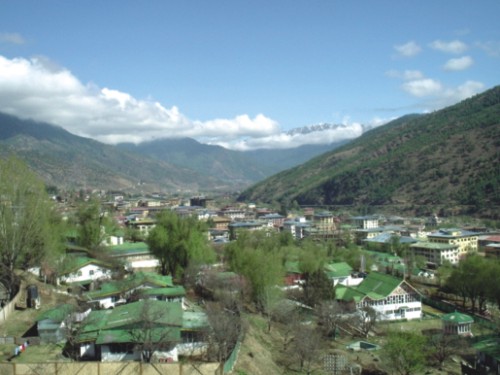|
Travel
Road
Trip to Bhutan
The
Unspoiled DRUK Land
Faizul
Khan Tanim
The
first thing that can break someone's reverie upon reaching
the Druk land is indisputably the serene and unspoiled beauty
of the state. High mountains -- often green and rocky, with
narrow rivers snaking their way through the rises, dazzling
white clouds, an immense amount of green and pine trees all
running parallel in the mind, defining the magnificence of
Bhutan.

Mask
dance festival in Paro |
If
one loves nature, it is always wise to take a joy ride in
order to experience the awe-inspiring scenery. If you take
a Dhaka-Shiliguri A/C bus service starting at around 9:00
pm (BST), which has recently opened from Dhaka, you can reach
the border Burimari in Lalmonirhat in a ten and half hours
drive.
Clearing
immigration and customs, depending upon the volume of passengers,
'Lays chips' packets, Gold Flake cigarettes -- Indian brands
will welcome you to the Indian side of the border Changrabandha.
It is wise to change your Bangladeshi currency and US dollars
from there.
Taxi cabs
-- Maruti mini buses and TATA Sumo jeeps will be waiting (which
is the transportation from the Indian side of the trip up
to Shiliguri). This time you are bound to miss the A/C comfort
and luxury bus that Dhaka had provided.
Once inside
the car, it will take you straight to Shiliguri. But those
who want to go to Bhutan are advised to take the taxi till
Moynaguri--a place in India from where buses leave for Jaigaon--India-Bhutan
border. It will be a dull three hours drive till you reach
the sight of rivers and the path through tea estates--suddenly
the bushy green tea plantations spring up -- a sight for sore
eyes.
Once you
reach Jaigaon, the quiet nice little town on one side facing
the hilly green side of Bhutan. You are in Bhutan a place
called Phuentsholing, which has to be crossed by the majestic
Royal Bhutan Gate. Anyone in Jaigaon can walk in and out from
the Bhutanese state Phuentsholing till 10:00 pm.
As one
enters Bhutan, friendly people in the traditional Bhutanese
attire of long robes in bright red and orange -- Gho for men
and Kira for women--will catch your eyes. The hilly streets,
clean surroundings, prayer flags adorning the mountain sky
line, plenty of green and the fresh air create a fairy-tale
like ambience.
Going
straight to the immigration office will be the wisest thing
for visitors if they want to visit Thimphu--the capital and
Paro. A special 'pass' will be given from that office which
will be asked for at check posts while entering Thimphu.
On a special
note, it is advisable for the tourists to wear trousers and
shoes to the immigration office as shorts and sandals are
not allowed inside the compound. Anyone who goes with sandals
has to leave them by the gate and walk barefoot.
Once the
immigration procedures are done, you are free to wander around
Phuentsholing and spoil yourself with the mouth-watering traditional
delicacies.
Traditional
Bhutanese food always features spicy red or green chilies.
A special dish known as 'Ema Datshi' is undoubtedly tasty.
Chilly, cheese and meat being the main ingredient, this dish
is certainly one of the hottest. It is said that a journey
to the Dragon Kingdom is incomplete without tasting this delicacy.
Small steamed dumplings called 'Momos' may be filled with
meat or cheese. This Tibetan-style dish is also common in
Bhutan and is scrumptious, fried or steamed.
Another
Tibetan dish 'Thukpa' (noodles), which may be fried or served
in soup, is a local delicacy. Other than these memorable treats,
their normal diet of rice and curry are very familiar to our
taste buds but with a major difference in ingredient--the
hot chilly paste which gives the food a totally different
aroma that can only be described as 'yummy'.

Gongzu/Memorial
Chorten in Thimpu |
Thimphu
The journey, rather the car-cruise from Phuentsholing to Thimphu
can be described as adventurous. Interestingly, the six hour
drive is not at all boring but refreshing. Mountains as high
as 8300 feet, clouds roaming in front of you as you cruise
on roads between big trees--the spellbinding journey can be
hazardous for heart patients as the path-way has steep sides
with hardly any railing on either side.
Thimphu
is the capital of modern Bhutan and the valley definitely
looks more crowded than the outskirts of the town. The houses
here are built differently with aesthetic designs, neat roads,
sights of sudden ice peaks and sun's rays playing with the
clouds--the small town looks like a pearl centred in a cup
of decorated shells.
Although
offices, shopping malls, hotels, restaurants and discos are
nicely arranged in that small town, the main attraction constitute
the temples and places of ritual -- the architecture is simply
dazzling and exquisite.

The
Royal Bhutan Gate (India-Bhutan border) |
Paro
A two hour drive by a taxi to Paro from Thimphu will bring
you to a relatively less hilly valley. Paro has the only airport
of the country, because of lack of plain land in the rest
of the country.
A narrow
airstrip which is used for both takeoff and landing, this
is rather small for an airport. A bird's eye view of the airstrip
is the ultimate spot for a photographer. The view is simply
awesome! The first thing one may encounter if one comes at
the right time (at the end of March) is the Tshechu Festival
or the mask dance festival which marks the Bhutanese annual
cycle. Visitors will be captivated on a cold March morning
with the mask and folk dances. This is the fourth day of the
five-day long festival at the Paro Rinpung Dzong courtyard.
The festival,
which can be compared with our Melas, also includes the sale
of artifacts, masks, and beautifully curved silver knives.
Land
of the Thunder Dragon
The most amazing fact about Bhutan is that the state's area
is 38,394 square kilometers with a population of around 6,99,000
and a currency with the same value as the Indian rupee. With
a stronger economy than Bangladesh, where one of their staple
exports is preserved fruit products, this nation produces
ample electricity and earns huge revenue from it. The popular
word 'load shedding' here is not in their dictionary as they
produce surplus amounts of electricity and export it to India.
Speaking to a few of the officials from their electrification
board, we learn that Bhutan has always been interested in
selling their surplus hydroelectricity to Bangladesh.
Monarchy
is still practiced in Bhutan. The land of the thunder dragon
is the mystical Buddhist kingdom. It is a well-preserved land
with religious and cultural traditions set in the spectacular
mountain ranges of the great Himalayas. The Bhutaneses' respect
for their King and the crown prince is striking. You won't
find a single shop which does not have pictures of the king.
The local people say the present King Jigme Singye Wangchuck
is a progressive leader and has continued in the modernisation
plans started by his father maintaining the policy and the
preservation of Bhutanese culture and tradition.

View of Thimphu
Copyright
(R) thedailystar.net 2005
| 